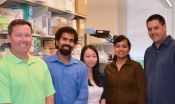Electronic 'tongue' to ensure food quality
2014-11-12
(Press-News.org) An electronic "tongue" could one day sample food and drinks as a quality check before they hit store shelves. Or it could someday monitor water for pollutants or test blood for signs of disease. With an eye toward these applications, scientists are reporting the development of a new, inexpensive and highly sensitive version of such a device in the journal ACS Applied Materials & Interfaces.
S. V. Litvinenko and colleagues explain that an electronic tongue is an analytical instrument that mimics how people and other mammals distinguish tastes. Tiny sensors detect substances in a sample and send signals to a computer for processing just as taste buds sense and transmit flavor messages to the brain. The food and beverage industry and others have started deploying electronic tongues for a range of purposes from authenticating Thai food to measuring beer quality. But existing devices are limited in how they can be used. Litvinenko's team decided to make an improved instrument that could have applications in medical diagnostics, pharmaceutical testing and environmental monitoring, as well as food testing.
The researchers developed a low-cost and environmentally friendly "e-tongue" with a silicon base that could be easily incorporated into existing electronic systems of the same material. When they tested it with Armagnac, cognac, whiskey and water, they were able to establish precise signatures for each. They conclude that their work serves as a first step toward a novel tasting instrument with potentially diverse applications.
INFORMATION:
The authors acknowledge funding from Lyon Science Transfert.
The American Chemical Society is a nonprofit organization chartered by the U.S. Congress. With more than 161,000 members, ACS is the world's largest scientific society and a global leader in providing access to chemistry-related research through its multiple databases, peer-reviewed journals and scientific conferences. Its main offices are in Washington, D.C., and Columbus, Ohio.
To automatically receive news releases from the American Chemical Society, contact newsroom@acs.org.
Follow us: Twitter Facebook
ELSE PRESS RELEASES FROM THIS DATE:
2014-11-12
The structure of a soccer player's face can predict his performance on the field--including his likelihood of scoring goals, making assists and committing fouls--according to a study led by a researcher at the University of Colorado Boulder.
The scientists studied the facial-width-to-height ratio (FHWR) of about 1,000 players from 32 countries who competed in the 2010 World Cup. The results, published in the journal Adaptive Human Behavior and Physiology, showed that midfielders, who play both offense and defense, and forwards, who lead the offense, with higher FWHRs ...
2014-11-12
Queensland University of Technology (QUT) researchers have found the habit of Googling for an online diagnosis before visiting the doctor can be a powerful predictor of infectious diseases outbreaks.
Now studies by the same Brisbane-based researchers show combining information from monitoring internet search metrics such as Baidu (China's equivalent of Google), with a web-based infectious disease alert system from reported cases and environmental factors hold the key to improving early warning systems and reducing the deadly effects of dengue fever in China.
Dr Wenbiao ...
2014-11-12
A new peer-reviewed study found that people are contaminated with several toxic flame retardants rarely studied in the US, including one that has never before been detected in Americans called TCEP. Scientists tested urine samples of California residents for biomarkers of six chemicals, all of which were present.
The scientists discovered a way to test for this class of toxic flame retardants (phosphates), which could open up a new wave of research into a group of pervasive flame retardants that were previously not studied nearly as much as some other flame retardants. ...
2014-11-12
Depression causes an average of 10 lost working days per episode
Managers report need for better legislation, training and counseling to tackle the problem
Right Direction Initiative developed to increase awareness of depression, reduce stigma associated with the disease in the workplace, and encourage employees to increase help-seeking behaviors
Canton, Ohio- November 12, 2014 - Nearly a quarter (23 percent) of U.S. respondents indicated they have been diagnosed with depression in their lifetime and two in five (nearly 40 percent) of those patients reported taking ...
2014-11-12
Cities have more species diversity than you'd expect. A study of ants in Manhattan found not only a wide range of species, but also significant differences in the levels of biodiversity in different urban areas.
"People don't think of cities as having ecology, and urban environments haven't been well studied," says Dr. Amy Savage, a postdoctoral biological sciences researcher at North Carolina State University and lead author of a paper on the work. "But protected areas, such as national parks, have been well studied. So we wanted to see if the theories developed to predict ...
2014-11-12
ANN ARBOR, Mich. -- There's a cast of characters deep inside your ears -- many kinds of tiny cells working together to allow you to hear. The lead actors, called hair cells, play the crucial role in carrying sound signals to the brain.
But new research shows that when it comes to restoring lost hearing ability, the spotlight may fall on some of the ear's supporting actors - and their understudies.
In a new paper published online first by the Proceedings of the National Academy of Sciences, researchers from the University of Michigan Medical School, St. Jude Children's ...
2014-11-12
New insights into how plants regulate their absorption of an essential nutrient could help avoid pollution caused by excess use of fertiliser.
The findings could lead to the development of crop varieties that need less of the primary nutrient - nitrogen - than conventional crops. It could also inform how much nitrogen should be added to plant feed.
This would allow optimum plant growth without producing excess nitrogen in run-off from fields, which is a major source of water pollution.
Agricultural fertilisers typically contain high levels of nitrogen that boost ...
2014-11-12
JUPITER, FL, November 12, 2014 - In a pair of related studies, scientists from the Florida campus of The Scripps Research Institute (TSRI) have identified a number of new therapeutic targets for memory disorders and have developed a new screening test to uncover compounds that may one day work against those disorders.
The two studies, one published in the journal Proceedings of the National Academy of Sciences (PNAS), the other in the journal ASSAY and Drug Development Technologies, could lead new approaches to some of the most problematic diseases facing a rapidly aging ...
2014-11-12
Medicine is drifting towards a major problem. An increasing number of bacteria is no longer sensitive to known antibiotics. Doctors urgently need to find new ways of fighting these multi-resistant pathogens. To address the problem, pharmaceutical research is turning back to the source of most of our drugs: nature.
Although hundreds of thousands of known active agents are found in nature, exactly how most of them work is unclear. A team of researchers from ETH Zurich has now developed a computer-based method to predict the mechanism of action of these natural substances. ...
2014-11-12
Speaking more than one language is good for the brain, according to new research that indicates bilingual speakers process information more efficiently and more easily than those who know a single language.
The benefits occur because the bilingual brain is constantly activating both languages and choosing which language to use and which to ignore, said Northwestern University's Viorica Marian, the lead author of the research and a professor in the department of communication sciences and disorders in the School of Communication. When the brain is constantly exercised ...
LAST 30 PRESS RELEASES:
[Press-News.org] Electronic 'tongue' to ensure food quality



